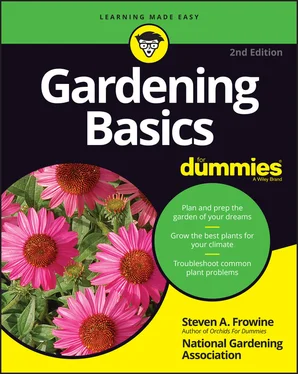Just buy the seed packets in late winter and sow them in flats or pots (particular directions are always on the back of the packets). Raise the seedlings indoors until spring weather comes and the soil warms up and all danger of frost is past; then move the plants outside.
Some annuals are so fast-growing that you can sprinkle their seeds on good soil in late spring, right outside, and they’ll quickly sprout and grow. This group includes popular ones like zinnias, marigolds, and nasturtiums. This process may require you to do some thinning at some point, but otherwise, it’s dead easy. Again, consult the back of the seed packet for details. One advantage to this tack is that you can grow some more unconventional or rare annuals. It certainly makes for a more interesting garden! Refer to Chapter 10for more about growing plants from seed.
Beholding a one-time show
The very definition of an annual — a plant that goes from seed to flowering to death in one season, completing its entire life cycle in short order — states that annuals are a one-time show. When it’s over, it’s over. (Except when it’s not; if you garden in a mild climate, many annuals merely slow down for the winter but survive. Snapdragons and many salvias are examples.)
If you garden in a cold climate, you can try digging up some favorites or bringing potted annuals inside. Keep them in a nonfreezing place, out of direct sunlight, and let them rest. Cut back all spent growth. Start reviving them with water and plant food when spring returns.
ANNUALS THAT AREN’T REALLY ANNUALS
False annuals are plants with tropical origins, or ones whose parents hail from the tropics, which means that they’re actually perennial — more long-lived — somewhere, somewhere warmer, somewhere far away like Costa Rica or Mexico. These pseudo-annuals, sometimes called tender perennials, can, at least in theory, be kept going over the winter and live to dress up your garden again next year. Examples of these tropical visitors include the coleus, geranium, impatiens, salvia, snapdragon, and wax begonia.
Meanwhile, biennials are plants that only live for two years. They grow their foliage and roots the first year and then flower the following year and then die. The most common examples are Canterbury bells, forget-me-nots, foxgloves, hollyhocks, pansies, stock, and verbascum (mullein). They frequently reseed themselves so some gardeners let them go to seed to ensure future plants. Most garden centers helpfully start these plants for you the season before or in early winter so they’re usually sold as annuals and flower the first year that you plant them.
However, if despite your best efforts, your wintered-over annuals don’t return to their former glory the following spring, accept their fate, pull them out, and replace them with new ones. Some of the annuals like marigolds, sunflowers, and zinnias reseed or self-sow themselves so they’ll sprout and grow plants the following spring when the ground warms. Depending on how aggressively they do this can be a good or bad thing.
For many gardeners, going from growing annuals to exploring perennials seems to be a natural progression. But remember that you don’t have to choose! You can grow both and, indeed, your garden is likely to be the better for the diversity.
So, what, exactly are perennials? One gardener jokingly defined a perennial as “A plant that, had it lived, would’ve bloomed again the next year.” For the most part, they’re long-lived herbaceous (non-woody) plants — flowers and herbs, mainly. How long they last depends on the plant and the conditions in your garden. But these plants certainly last longer than annuals.
A typical perennial emerges in the spring, grows and often produces flowers and seeds as the seasons progress from spring to summer to fall, and then slows down or dies back in winter. But the plant doesn’t actually die; it just rests. The following spring, your perennial returns in glory to repeat the cycle.
Unlike annuals, you don’t have to replant perennials every year. Once should be enough — well, if you choose wisely and take good care of your perennials, you ought to get many good years out of them.
Eventually, though, some perennials run out of steam. Their growth gets crowded and they don’t seem to flower as well. At this time, you can dig them out and replace them, or you can divide them (perhaps discarding the tired-out center, or mother plant) and replant well-rooted bits for a fresh new start.
Here are some of the many uses of perennials:
Creating a colorful bed or border
Filling an island bed (an isolated, self-contained garden, like an island in a sea of lawn)
Mixing them with annuals to assure summer-long color
Edging a walkway, patio, pool area, or deck
Interplanting them with roses, annuals, or other ornamental shrubs to provide year-round interest
Dressing up an area that was formerly lawn
For the nitty-gritty details on perennials, check out Chapter 7. If you just want the basics, read on.
IN ON THE GROUND FLOOR: GROUNDCOVERS
Low-growing perennial plants may be handy in a flower border (near the front where they won’t be blocked from view) or as an edging, but they have another, very practical use: You can plant entire areas with them, and they can form a low-care carpet. Groundcovers are problem-solvers for difficult-to-landscape areas such as shady areas, including under trees where lawn won’t grow, or areas where you don’t want to or can’t easily mow such as slopes/embankments.
Some favorite groundcovers include ajuga, candytuft, creeping phlox, epimedium, hosta, ivy, lamium, lily-of-the-valley, pachysandra, sweet woodruff, verbena, and vinca. For details on groundcovers, turn to Chapter 14.
Caring for and feeding perennials
The water needs of perennials vary. Some are moisture-lovers, others are drought-tolerant, and many are somewhere in the middle. Do your homework when choosing plants, not just on what they prefer but on which ones are suitable to the growing conditions in your yard and climate (otherwise, you’ll be jumping through hoops trying to please them). Chapter 2can help you get a grip on how to plan your garden.
One generalization is possible, though: Nothing makes newly planted perennials feel more welcome than plentiful water does. The perennials have gone from a sheltered and confining life in a pot to the wide world of your garden, and water helps sustain the roots and encourages them to establish themselves and expand into their new home.
Many perennials (like most people) enjoy being fed. They respond by growing more robustly and producing more flowers. You’re fine with a general, all-purpose garden fertilizer, applied according to the label directions during the height of the growing season. Don’t feed your perennials as fall approaches and growth naturally begins to slow. You don’t want them producing a fresh new flush of growth that soon gets nipped by a frost. (For some general info on fertilizing, see Chapter 4.)
I have to admit that fertilizing the majority of perennials isn’t mandatory. If you plant them in soil that suits them (and do your homework when choosing the plants), they may do just fine without it. Good, organically rich soil and good growing conditions and regular water can sustain healthy, hearty perennial growth for quite some time. Fertilizing merely supplies a boost in these cases.
The life cycle of a perennial depends on various factors, notably the type of plant and whether it’s happy in your garden. But you can certainly expect to get a minimum of two years and a maximum of a decade out of the vast majority of perennials. For best results, of course, take good care of them.
Читать дальше












